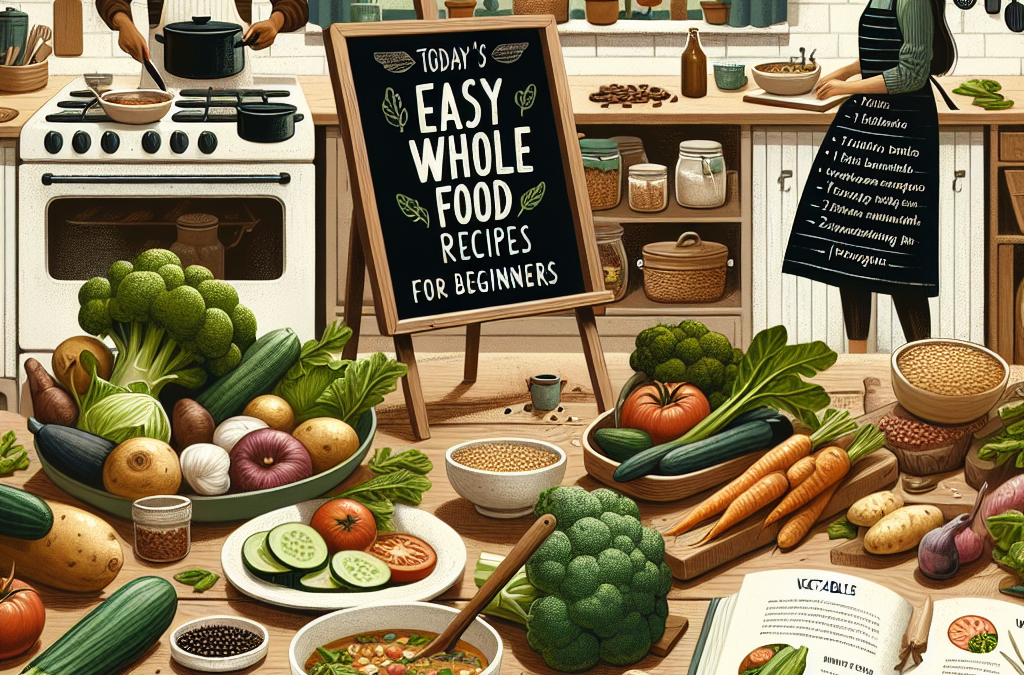Get an Amazing Discount on Best Organic SuperFood Product!
Easy Whole Food Recipes for Beginners
Table of Contents
- Simple Ingredients for Whole Food Recipes
- Quick Cooking Techniques
- Flavorful Whole Food Combinations
- Meal Prep Made Easy
Simple Ingredients for Whole Food Recipes
Understanding Whole Foods
When I first dove into the world of whole foods, I was a little overwhelmed by what it all meant. Whole foods are basically those ingredients that are minimally processed and free from artificial substances. Think fresh fruits, vegetables, whole grains, nuts, and seeds. These foods are not just good for your body; they also make cooking way more enjoyable.
Plus, I noticed that using wholesome ingredients elevated my meals without having to fuss too much. You don’t need a fancy degree to whip up something fantastic. Just grab the good stuff straight from the earth, and you’re golden!
It’s important to read labels and get familiar with what you’re buying. When I started, I’d find hidden sugars or preservatives in what I thought were healthy options. Bouncing from the grocery store to farmer’s markets helped me understand the best choices for my kitchen.
Shopping Tips
I’ll let you in on a little secret – shopping for whole foods can actually be fun! I recommend heading to your local farmer’s market whenever possible. Not only are you supporting local farmers, but you also get produce that’s in its prime.
Another tip is to stick to the perimeter of the grocery store. That’s where the fresh food hangs out. The inner aisles are often stocked with processed items that just don’t cut it. Focus on stocking up on essentials like leafy greens, beans, and grains.
Remember, a great tip I learned early on is to plan your meals around what’s on sale or what looks freshest. This not only keeps it budget-friendly but also keeps the meals vibrant and varied!
Creating a Solid Pantry
Building a solid pantry is like setting a solid foundation for a house. You’d want staples like brown rice, quinoa, lentils, and canned tomatoes.
I always keep a variety of dried herbs and spices on hand. They really take whole food ingredients from bland to grand in minutes. I’m talking about garlic powder, cumin, and chili powder—they work wonders!
And don’t forget about your frozen section! Frozen veggies and fruits are great for quick meals. They’re frozen at their peak freshness, so you’re still getting tons of nutrients.
Quick Cooking Techniques
Mastering Basic Cooking Methods
One of the best lessons I learned when I started my cooking journey was to master a few basic techniques. Sautéing, steaming, roasting, and boiling can transform simple ingredients into stunning meals.
For sautéing, I love using olive oil and garlic as my base. Throw in some chopped veggies and you’ve got a delicious stir-fry in no time. It’s quick, easy, and allows for so much variety; you can literally use whatever’s left in your fridge!
Steaming veggies is another straightforward method that keeps the flavor intact and nutrients locked in. I usually steam broccoli or carrots; just a couple of minutes, and they’re crispy yet tender.
One-Pot Wonders
One-pot meals are a blessing, especially for someone like me who hates doing dishes. I can toss everything into a pot, let it do its thing, and I’m all set.
Think about creating a big pot of chili or a hearty stew. Just gather your chopped vegetables, some beans, and a couple of spices and let it simmer away. It’s low-maintenance, and the leftovers are always even better!
I love to throw everything in the slow cooker before work. When I come home, my meal is ready to go—nothing feels better after a long day than a warm meal waiting for you.
Experimenting with Flavors
Don’t be afraid to mix things up. Cooking is a creative process, and finding the right flavors is part of the fun! Try adding a splash of lemon juice to roasted veggies or a sprinkle of balsamic vinegar with your salads.
Another trick I have up my sleeve is using homemade sauces. A simple homemade vinaigrette can elevate a basic salad and brings in fresh flavors that store-bought just can’t match.
Plus, spices can change the game entirely. I’ve found that a little bit of curry powder or smoked paprika can totally transform a dish and make it sing. So, always be ready to experiment!
Flavorful Whole Food Combinations
Certainly Delicious Pairings
Now, while whole foods on their own are fantastic, when you combine them, you’re in for a treat. Some combinations I rave about are quinoa with black beans and avocado, or roasted sweet potatoes with kale and chickpeas.
For breakfast, I love topping my oatmeal with some fresh fruits, nuts, and a drizzle of honey. It’s such a fulfilling start to the day, and it keeps me energized.
Plus, don’t underestimate the power of a good smoothie! Throw in some spinach, banana, and almond milk, and you’ve got a nutritious drink that you can take on the go.
Creating Balanced Meals
One thing I always aim for is creating balanced meals that include a lean protein, healthy fats, and plenty of colorful veggies. This not only keeps it wholesome but also satisfying.
For instance, a grilled chicken salad with mixed greens, avocado, and a homemade dressing provides everything you need in one bowl. It’s filling, fresh, and oh-so-tasty.
Over time, you’ll discover recipes that work well for you regarding balance. The key is experimenting and finding what makes you feel good.
Trying New Whole Foods
Every now and then, I grab something at the store I’ve never tried before. Recently, I picked up farro, a wonderful grain that I tossed into a vegetable stir-fry; it added an amazing chewy texture!
Don’t shy away from trying new fruits and veggies too. Something like dragon fruit can be fun and adds a pop of color to your plate. It’s all about exploring what the earth has to offer!
Meal Prep Made Easy
Planning Your Meals
Meal prepping has saved my life, honestly. It’s essential to plan ahead to make healthy eating easier during the week. I usually sit down every Sunday to plan meals and snacks for the week.
I recommend making a big batch of something that can carry you through multiple meals, like whole grain pasta or a large pot of soup. Then, you can mix and match throughout the week without getting bored.
Not only does planning help reduce waste, but it’s also a time-saver. Whenever I’m in a pinch, I just grab something from the fridge and know it’s a healthy choice.
Storing Foods Properly
Proper storage is key for meal prep. I often use clear containers to store my grains, proteins, and veggies, which makes it easy to see what I have on hand.
I’ll separate portions for lunch and dinner, which helps to avoid temptation to grab that take-out menu. Preparing them in advance keeps everything fresh and nutritious!
An added tip is to label your containers with the date. It keeps things organized, making it less likely that I’ll forget about that batch of roasted veggies hiding in the back of the fridge.
Easy Grab-and-Go Options
Life can get hectic, and I need snacks that I can just grab and go. Having things like oatmeal packets, homemade granola bars, or pre-peeled carrots and hummus on hand can be a lifesaver.
I like to make a few energy balls with oats, nut butter, and some chocolate chips for those sweet cravings. They’re easy to make, easy to store, and perfect for a quick snack when I’m on the run.
Those 3 p.m. cravings can hit hard, but with prepared snacks, I’m not tempted to reach for something unhealthy. Keeping whole foods handy keeps me feeling good throughout the day!
FAQs
What are whole foods?
Whole foods are natural ingredients that are minimally processed and free from artificial substances. They typically include fruits, vegetables, whole grains, nuts, and seeds.
How can I start meal prepping?
Start by planning your meals for the week and making a shopping list. Pick a day to cook and prepare your meals in batch, using clear containers for easy access during the week.
What are some quick cooking techniques I can use?
Basic techniques like sautéing, steaming, and roasting can take simple ingredients and turn them into delicious meals. Additionally, one-pot meals are fantastic for reduced cleanup!
How do I create balanced meals?
Aim to include a lean protein, healthy fats, and a variety of colorful vegetables in your meals. This balance is satisfying and can keep you energized throughout your day.




